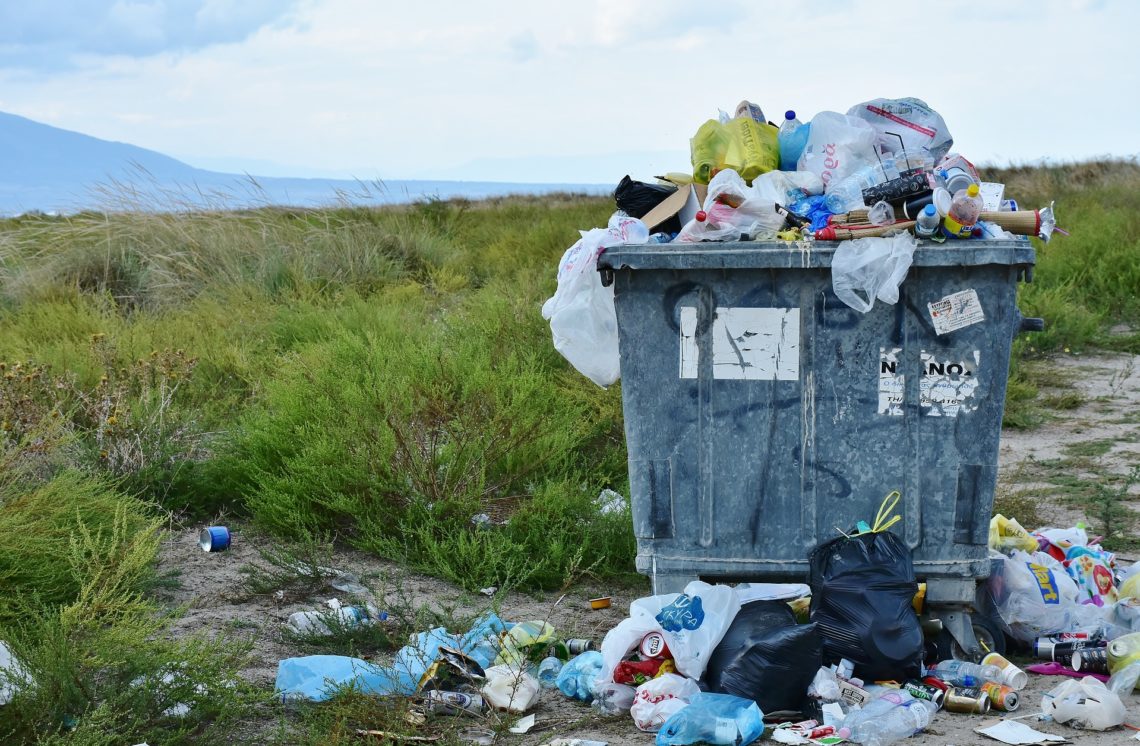by Max Brown
Plastic is undoubtedly the most widely used material on the planet, finding its way into practically every consumer product. In tandem with this global use is global pollution, and the problems of plastic pollution have risen to the forefront of issues facing humanity. Plastics are durable products, with an estimated lifespan of hundreds of thousands of years, translating into a worldwide issue of massive waste that poses an incomprehensible threat to the environment (Xanthos & Walker, 2017). It is estimated that by 2025, there will be one ton of ocean plastic for every three tons of fish (Forrest, Giacovazzi, Dunlop, Reisser, & Tickler, 2019). Additionally, the plastic economy is not sustainable; new fossil-fuel derived plastic (FFP) enters the oceans and environment as waste rather than being recycled and reused, perpetuating a vicious attack on the planet. Both the amount of new plastics made and the rate of production of these plastics are increasing, causing the biggest public health issue and environmental threat to the planet. In order to combat and eliminate this pervasive problem, a voluntary industry-led contribution from new FFP production is critical to halting plastic waste flows by turning used plastic into a commodity instead of a resource to be wasted. Without widespread overhaul and transformation of the way plastic products are treated, humanity and the environment face an uncertain future.
Widespread pollution from plastics has become a ubiquitous and persistent issue in today’s world, accumulating in and harming the planet’s soil, oceans, and air. Furthermore, the production of plastic is not sustainable, as it creates a linear economy due to the fact that plastics are almost never recycled. Of the 6.3 billion tons of FFP waste produced to date, only 9% has been recycled; the rest being incinerated (12%) or dumped into the environment (79%) (Forrest et al., 2019). Daily, approximately 8 million pieces of plastic pollution find their way into the oceans, and plastics consistently make up 60 to 90% of all studied marine debris (Surfers Against Sewage, 2019). Most detrimental to the plastic problem is the copious consumption of single-use plastics (SUPs). Over 300 million metric tons of plastic are produced annually, and 50% are discarded after a single use (Schnurr et al., 2018). SUPs include plastic bags, straw, cutlery, and microbeads—products that see widespread use nearly every day. Plastic pollution, especially from SUPs, is incredibly detrimental to the health of land and marine animals, and the harm to human health is becoming increasingly more apparent. The most visible impact of plastic pollution can be seen in marine wildlife, which ingest and become tangled in FFP with extreme consequences. Millions of marine animals of at least 260 species die annually due to interactions with FFP, and these numbers are likely to increase as smaller organisms are examined (Forrest et al., 2019). As plastics fragment and disperse, they become even more problematic; micro-particles of plastic contain toxic dyes and flame retardants that can contaminate organisms upon ingestion and potentially affect human consumers of seafood. Micro-plastics have the capability of causing intracellular damage, inflammation in digestive and respiratory systems, and compromised fecundity and reproduction (Forrest et al., 2019). The plastic problem is a pervasive one that threatens much of the life on Earth.
At the heart of the plastic waste problem lies the fact that the plastic economy is a linear economy. Without proper recycling, FFP pollution will continue to increase and jeopardize marine life and humankind. Furthermore, plastic pollution stems from the way in which plastics are treated as an inconsequential and infinite material, rather than the deleterious and finite resource that they truly are. Because the problem of plastic pollution is one that desperately needs immediate attention, only industry has the reach and power to tackle this crisis with the needed urgency. To combat this issue, the plastic economy must be fully reconstructed and become a circular economy of sustainability. As it stands today, the price of synthesizing new FFPs is slightly less expensive than recycling plastic through a process of melting products down to a moldable resin (TED, 2019). It makes economic sense, then, that businesses would be adverse to utilizing recycled plastic. This price differential perfectly explains why only 9% of plastic waste is recycled (Forrest et al., 2019). The processes behind making good, recycled plastic simply cannot compete with plastic made from fossil fuels, despite the fact that the technologies to recycle plastics are scalable.
The solution to the problem is abundantly clear: switch the prices of these two types of plastic. Through a voluntary contribution from companies that produce the building blocks for FFPs, including ExxonMobil, Dow Chemical, and Chevron Phillips, wherein these companies purposefully raise the price of their products, plastic can be considered a commodity instead of waste. Once the prices of these two plastics are inverted, recycled plastics, the sustainable option, become more economically attractive than FFPs. The estimated value of industry contribution sits in the range of US $200 to US $5,000 per ton in order to incentivize the collection and recycling of used FFP (Forrest et al., 2019). The impact of this change in price would be inconsequential to consumers—the public would see barely a quarter of a cent increase in the average price of plastics (TED, 2019). This voluntary contribution would not be without incentive for these oil and gas companies. By creating an economic margin, the contribution will synthesize considerable funds to tackle the plastic issue through investment in transformative technologies and by funding environmental remediation (Forrest et. al, 2019). Turning plastic into a cashable commodity will reward plastic recovery and increase recycling rates. This initiative would also provide job opportunities for millions of people, especially those living in developing countries that are disproportionately affected by the plastic problem (Beals, 2019). Once plastic becomes an article of value, plastic collection for recycling becomes a profitable job opportunity, and recycling centers can be built in affected countries that will become home to an increasingly large job market.
Other propositions to combat plastic waste exist, but become problematic because they do not address or solve the issue of the linear plastic economy. Governments have struggled for decades to solve the marine plastic pollution issue, with little success. For instance, the International Convention for the Prevention of Pollution From Ships (MARPOL 73/78) was signed in 1973 by 134 countries, instituting a complete ban on the disposal of plastics at sea when fully enacted in 1988 (Xanthos & Walker, 2017). Research has shown, however, that the problem of marine debris has worsened since MARPOL 73/78 was signed (Xanthos & Walker, 2017). Widespread policy solutions like MARPOL 73/78, while they appear intuitively promising, do not fulfill the necessary requirements to become sufficiently impactful. At smaller levels, government intervention aimed at mitigating the use of SUPs have become increasingly more ubiquitous worldwide, and see moderate levels of success. These interventions range from levies on plastic bags, like in New York City, to widespread bans that prohibit the use of all plastic bags in supermarkets, a policy implemented in France in 2017 (Schnurr et al., 2018). While these policies are certainly a step in the right direction, the issue of plastic pollution has become too significant to be solved in such a way. Truly, the urgent change that is needed to solve this problem of pollution cannot be fulfilled without industry-led economic overhaul.
Opponents of this proposal argue that the only solution to solving the problems associated with plastic pollution is to eliminate the use of plastics altogether. If consumers simply arrest their use of plastic products, the issues of pollution will disappear. While an increased reduction in plastic use will certainly be important in addressing pollution, the notion that this will solve the problem is an idealistic one at best. Plastic products are too important and fundamental for the modern consumer. Additionally, a legal and economic system that favors corporate generation of plastic, coupled with public acceptance of single-use items as part of the modern economy, leaves consumers who want to reduce their plastic footprint faced with a host of challenges (Wilkins, 2018). While individuals can do their best to minimize their impact, it is unreasonable to assume that consumers worldwide are capable of such a feat. Essentially, the acceptance of individual responsibility for a problem that individuals have little control over is an ineffective method of handling pollution. The source of plastic production must be addressed, and the solution must come from there as well.
Plastic pollution is one of the preeminent threats to all aspects of the planet, damaging societies, economies, and natural environments, especially the world’s oceans. Because the plastic problem has become a global one, the solution must be equally universal. A broad, economic approach must be taken to catalyze change in the form of a voluntary contribution from the global plastics industry to turn plastic into an article of value. This contribution will jump-start the transition from a linear plastic economy to a circular one, providing a sustainable means of eliminating worldwide pollution. Without drastic change, plastic pollution will cause irreversible damage to the environment and to human health. If properly implemented, the proposed initiative can provide the necessary solution to this problem with far-reaching effects, from arresting the flow of plastics into oceans to giving economic opportunities to individuals in developing countries. Future generations deserve to be protected from the toxicity of plastic waste, and a circular plastic economy can provide that protection.
References
Beals, R. K. (2019, September 27). Metals billionaire Andrew Forrest is making a $300 million bet on the next big commodity — plastic. Retrieved from https://www.marketwatch.com/story/metals-billionaire-andrew-forrest-is-making-a-300-million-bet-on-the-next-big-commodity-plastic-2019-09-25.
Forrest, A., Giacovazzi, L., Dunlop, S., Reisser, J., & Tickler, D. (2019, September 25). Eliminating Plastic Pollution: How a Voluntary Contribution From Industry Will Drive the Circular Plastics Economy. Retrieved from https://search-proquest-com.proxy.consortiumlibrary.org/docview/2299209756?pq-origsite=summon.
Schnurr, R. E. J., Alboiu, V., Chaudhary, M., Corbett, R. A., Quanz, M. E., Sankar, K., … Walker, T. R. (2018, October 12). Reducing marine pollution from single-use plastics (SUPs): A review. Retrieved from https://www-sciencedirect-com.proxy.consortiumlibrary.org/science/article/pii/S0025326X18307033.
Surfers Against Sewage. (2019). Plastic Pollution – Facts and Figures. Retrieved from https://www.sas.org.uk/our-work/plastic-pollution/plastic-pollution-facts-figures/.
TED. (2019, November 1). A radical plan to end plastic waste | Andrew Forrest. Retrieved from https://www.youtube.com/watch?v=I5g9-4fx60A.
Wilkins, M. (2018, July 16). More Recycling Won’t Solve Plastic Pollution. Retrieved from https://blogs.scientificamerican.com/observations/more-recycling-wont-solve-plastic-pollution/.
Xanthos, D., & Walker, T. R. (2017, February 21). International policies to reduce plastic marine pollution from single-use plastics (plastic bags and microbeads): A review. Retrieved from https://www-sciencedirect-com.proxy.consortiumlibrary.org/science/article/pii/S0025326X17301650.






One Comment
Julia
I am speechless! This is very well put together and informative. Why is this not posted anywhere else ? Many thanks to the author for writing this. It’s saddening how individuals are unaware of how bad our plastic issue is. I admire how factorial information was presented to make the issue apparent to others.